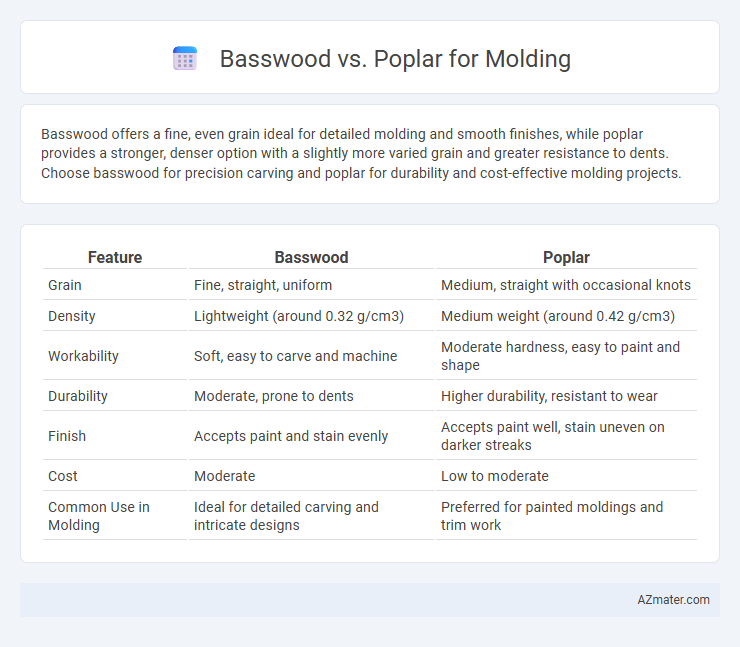Basswood offers a fine, even grain ideal for detailed molding and smooth finishes, while poplar provides a stronger, denser option with a slightly more varied grain and greater resistance to dents. Choose basswood for precision carving and poplar for durability and cost-effective molding projects.
Table of Comparison
| Feature | Basswood | Poplar |
|---|---|---|
| Grain | Fine, straight, uniform | Medium, straight with occasional knots |
| Density | Lightweight (around 0.32 g/cm3) | Medium weight (around 0.42 g/cm3) |
| Workability | Soft, easy to carve and machine | Moderate hardness, easy to paint and shape |
| Durability | Moderate, prone to dents | Higher durability, resistant to wear |
| Finish | Accepts paint and stain evenly | Accepts paint well, stain uneven on darker streaks |
| Cost | Moderate | Low to moderate |
| Common Use in Molding | Ideal for detailed carving and intricate designs | Preferred for painted moldings and trim work |
Introduction to Basswood and Poplar for Molding
Basswood and poplar are popular choices for molding due to their lightweight and fine grain characteristics, making them easy to cut and shape with precision tools. Basswood is valued for its softness and smooth texture, which allows for detailed carving and minimal splintering, ideal for intricate molding designs. Poplar offers durability and a uniform grain, providing a stable finish that accepts paint well, making it suitable for both decorative and functional molding applications.
Botanical Origins and Characteristics
Basswood, derived from the Tilia genus, is a lightweight hardwood known for its fine, even texture and pale cream color, making it ideal for intricate molding work due to its ease of carving and sanding. Poplar, sourced from the genus Populus, offers a slightly harder surface with a straight grain and a range of colors from creamy white to greenish or brownish hues, providing durability and smooth finishes in molding applications. Both woods are favored in woodworking but differ botanically and in handling properties, influencing their selection based on project requirements.
Grain Patterns and Appearance
Basswood features a fine, even grain pattern that provides a smooth surface ideal for detailed molding projects, offering a clean and uniform appearance. Poplar displays a straighter, more pronounced grain with occasional streaks, giving molding a subtle texture and varied visual interest. The lighter color of basswood tends to take paint evenly, while poplar's natural finish often highlights its characteristic grain variations.
Workability and Ease of Cutting
Basswood offers superior workability and ease of cutting compared to poplar, making it a preferred choice for intricate molding designs. Its fine, uniform grain and softness allow for smoother cuts and detailed shaping without splintering. Poplar, while still workable, tends to be denser and may require sharper tools and more effort during cutting, which can impact precision in molding projects.
Paint and Finish Compatibility
Basswood offers excellent paint and finish compatibility due to its fine, even grain, allowing for smooth, uniform coatings with minimal prep work. Poplar is also paint-friendly but may require additional sanding or primer to prevent blotchy finishes because of its coarser texture and occasional color variation. Both woods respond well to common primers and paints, but basswood's consistent surface makes it the preferred choice for high-quality painted molding projects.
Durability and Strength Comparison
Basswood offers moderate durability with a fine, even grain that makes it easy to work with for detailed molding, but it is softer and less resistant to dents compared to poplar. Poplar provides greater strength and durability, featuring a harder wood density that withstands impacts and wear better over time, making it ideal for high-traffic areas. For molding applications where toughness and longevity are priorities, poplar is generally the superior choice.
Cost and Availability
Basswood and Poplar are popular choices for molding, valued for affordability and availability. Basswood typically costs more due to its fine grain and ease of carving, making it ideal for intricate designs, while Poplar is usually less expensive and widely available in most lumberyards. Poplar's consistent supply and lower price make it a cost-effective option for large-scale projects, whereas Basswood suits detailed molding requiring a smoother finish.
Common Uses in Molding Projects
Basswood is widely favored in molding projects for its fine, even texture and ease of carving, making it ideal for intricate, detailed trim and decorative moldings. Poplar, known for its durability and smooth finish, is commonly used in baseboards, door casings, and window trims where strength and paintability are essential. Both woods offer versatility, but basswood excels in aesthetic molding work while poplar provides cost-effective, sturdy solutions for structural molding applications.
Sustainability and Environmental Impact
Basswood and poplar both offer sustainable options for molding, with basswood being a fast-growing species that sequesters carbon efficiently, promoting a lower environmental footprint. Poplar also grows rapidly and is often sourced from managed plantations, which helps reduce deforestation and supports ecological balance. Both woods are biodegradable and recyclable, making them environmentally responsible choices for molding applications.
Choosing the Right Wood: Basswood or Poplar for Your Molding Needs
Basswood offers a fine, even grain that sands smoothly and accepts paint exceptionally well, making it ideal for detailed molding projects requiring a crisp finish. Poplar is slightly harder and provides good stability with a straight grain, often preferred for its durability and resistance to dents in high-traffic areas. Choosing between basswood and poplar hinges on the desired balance of softness for carving detail versus toughness for long-lasting structural trim.

Infographic: Basswood vs Poplar for Molding
 azmater.com
azmater.com